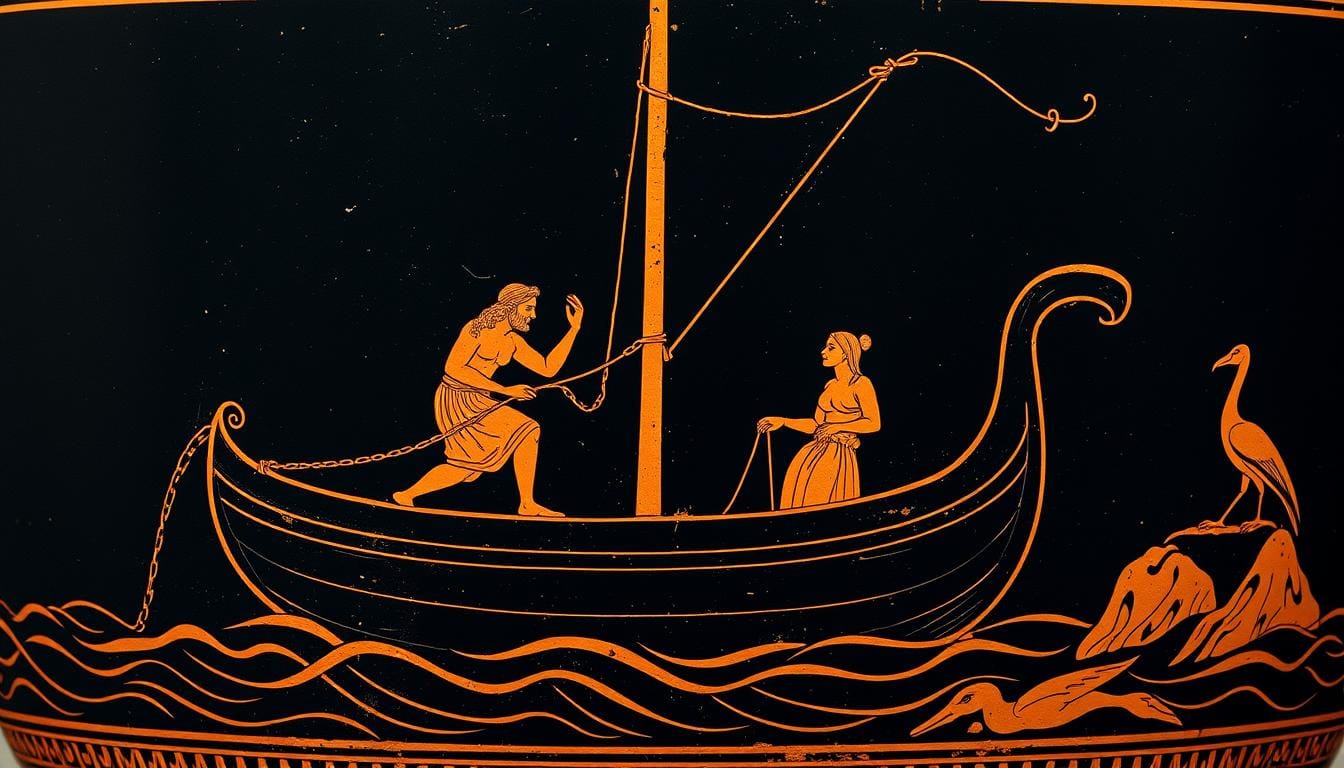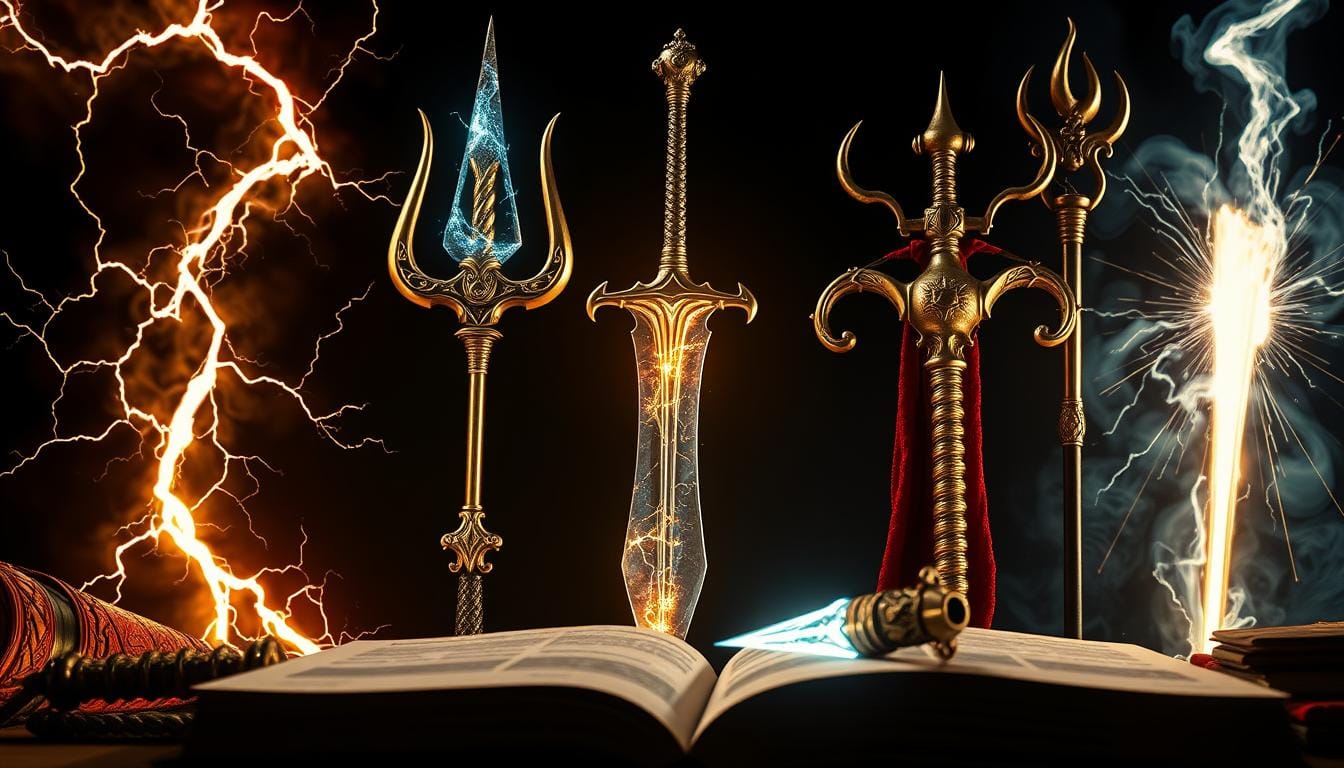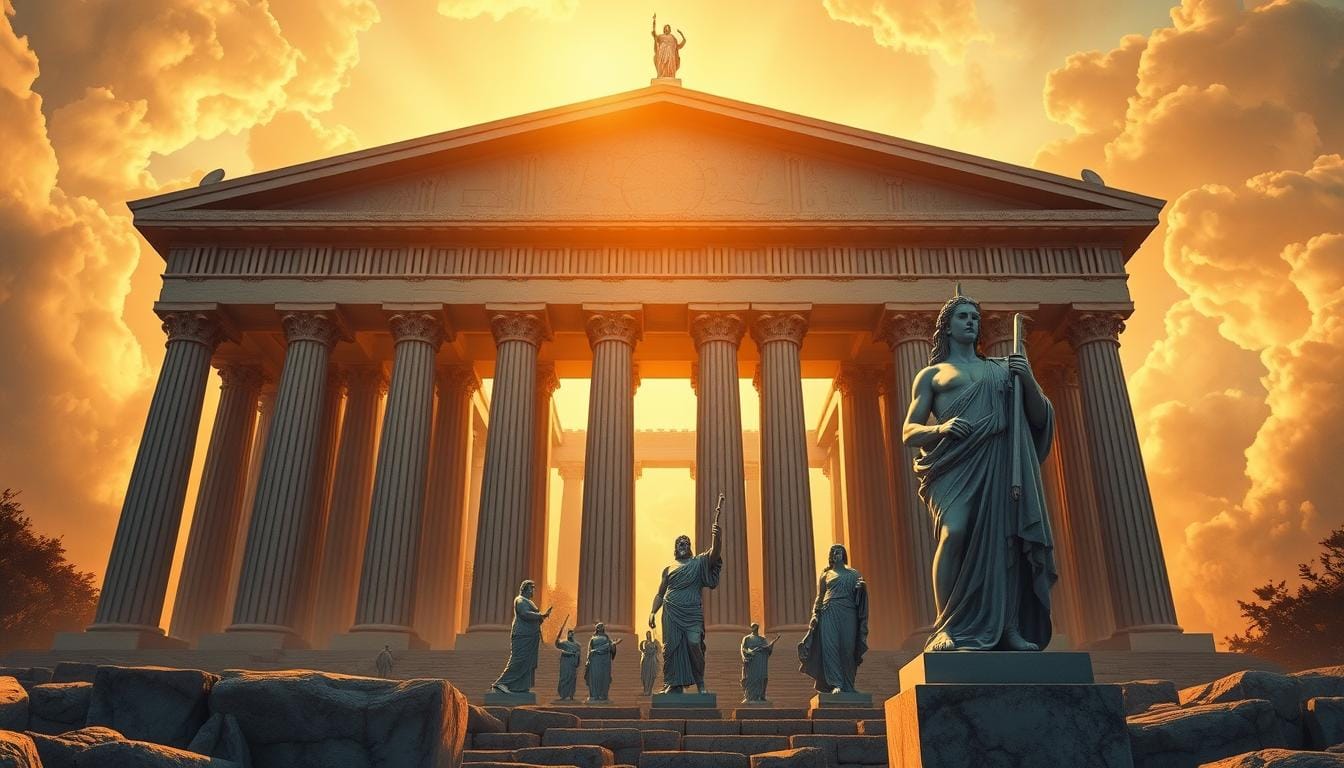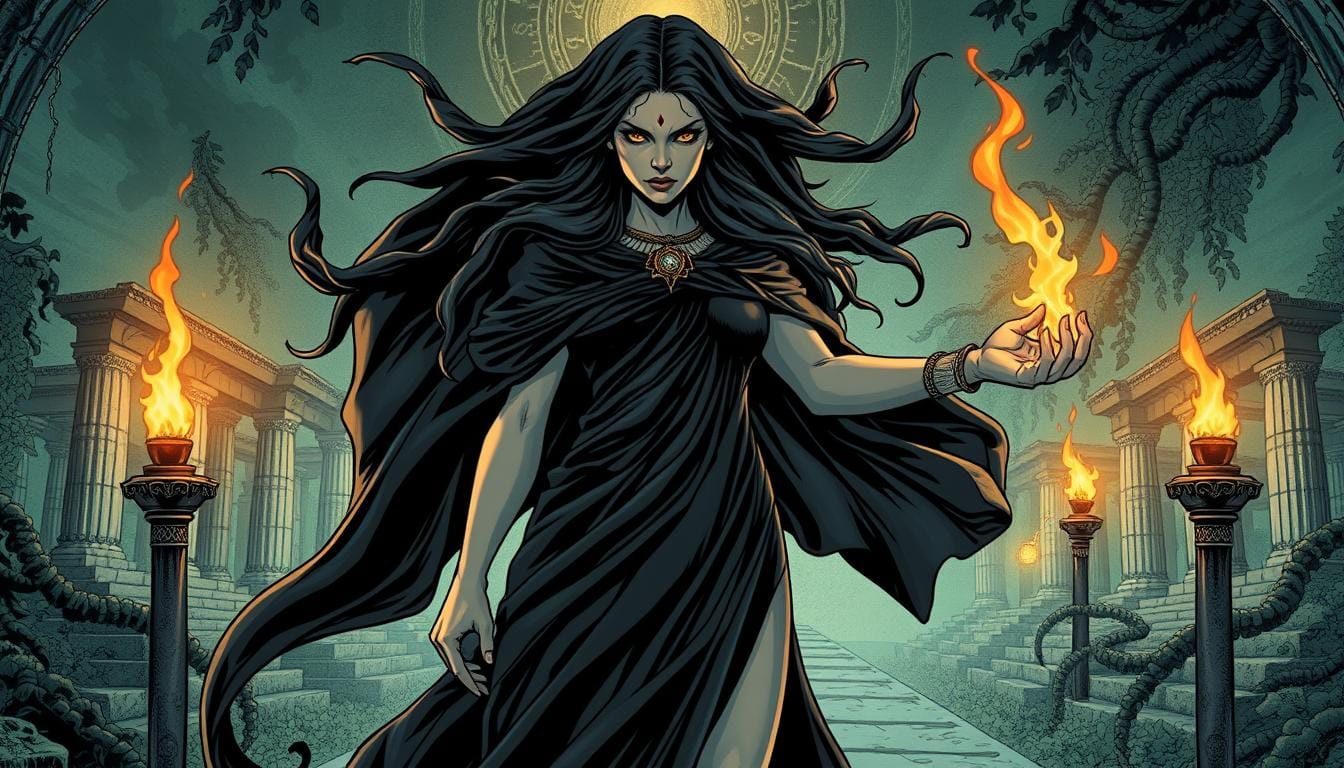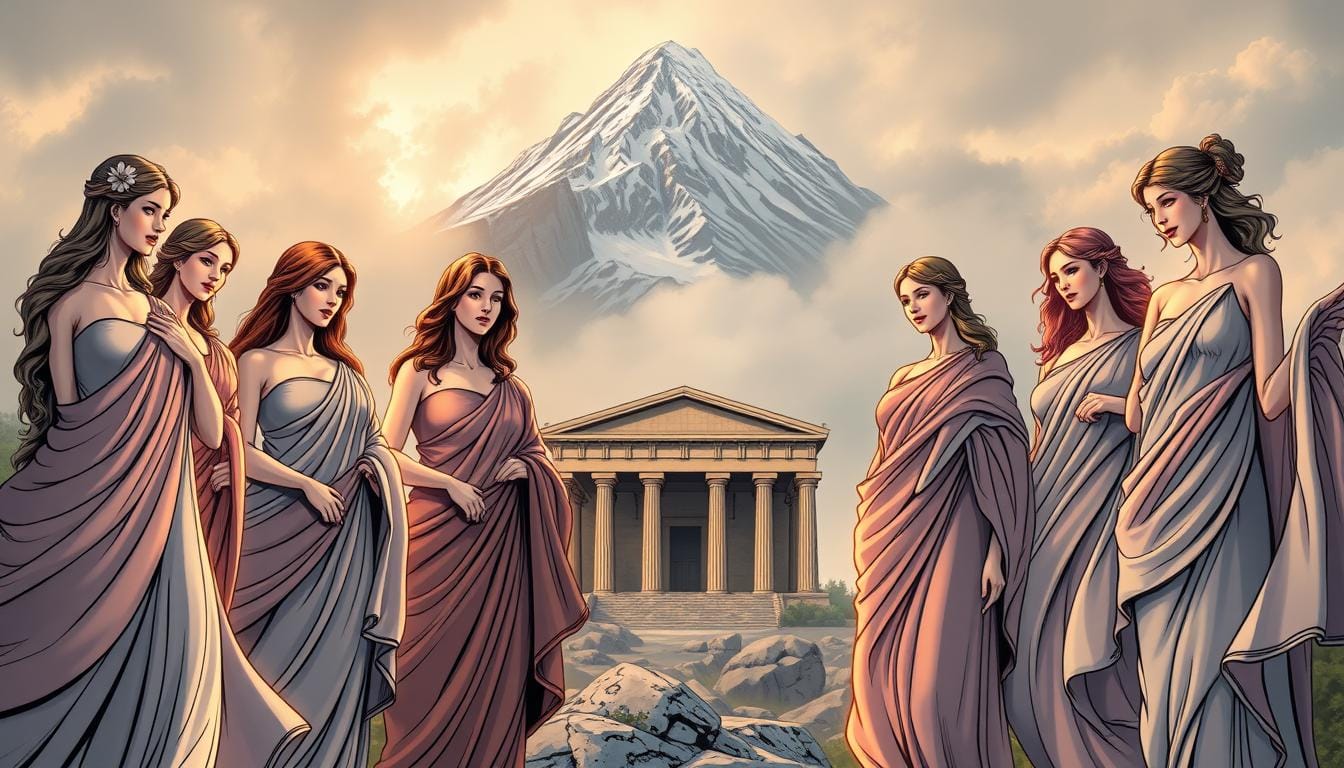Among the most captivating legendary tales of ancient Greece is the story of a Perseus hero. He bravely faced the impossible. This demigod, once a helpless infant cast adrift, became one of history’s most celebrated heroes.
Born to mortal princess Danaë and mighty Zeus, Perseus had both human courage and divine strength. His early survival against odds showed he was destined for greatness in Greek mythology.
Perseus’s greatest challenge was facing Medusa, the terrifying Gorgon. Her deadly gaze could turn any living creature to stone. This quest made him a legend in ancient myth.
This heroic journey has inspired many for generations. It shows that some stories are timeless, crossing cultural boundaries.
Key Takeaways
- Perseus was the son of Zeus and Princess Danaë, combining divine power with mortal determination
- He survived being cast into the sea as an infant, demonstrating his extraordinary destiny from birth
- The hero’s greatest achievement was slaying Medusa, the deadly Gorgon whose gaze turned mortals to stone
- Perseus represents the archetypal hero in Greek mythology, embodying courage against impossible odds
- His legendary tale has influenced countless works of art and literature throughout history
- The story showcases the classic mythological theme of divine intervention in mortal affairs
Introduction

In Greek mythology, Perseus stands out as a hero whose path was influenced by both human dreams and divine help. His journey is more than just a story of bravery and sacrifice. It’s a mix of courage, giving up for the greater good, and supernatural aid.
The mythological quest that made him famous wasn’t his choice. It was forced upon him by those who wanted to use his good heart for their own gain.
Perseus’s journey from a caring son to a legendary fighter is truly inspiring. He bravely took on a task that seemed impossible. This shows his heroic spirit and sets him apart from others.
His story shows how human wishes and divine plans can mix in ancient Greek myths. This mix makes his journey so compelling.
The Legendary Quest of Perseus
Perseus’s adventure started when King Polydectes wanted to get rid of him. Polydectes had his eye on Perseus’s mother, Danaë. He knew Perseus would never let him have her.
The king came up with a clever but cruel plan. He tricked Perseus into going on a dangerous quest. Polydectes hoped this would kill the young hero.
At a feast, Polydectes said he wanted to marry. Perseus, feeling ashamed, promised to bring back Medusa’s head. This was a task that seemed impossible for any human.
Perseus’s love for his mother and his bravery caught the gods’ attention. Athena, Hermes, and Hades saw his good heart. They gave him the tools he needed to succeed.
A Hero's Fate Intertwined with a Monster's Curse
The story of Perseus and Medusa is more than just a battle. It shows how heroism can come from the toughest challenges. Medusa, once beautiful, became a monster. She was the reason for Perseus’s journey to become the Medusa slayer.
This myth shows that ancient Greeks saw heroism as something earned. Perseus’s bravery and the gods’ help proved his worth.
“The hero’s journey begins not with strength, but with the courage to face the impossible.”
Perseus’s story makes him more than just a warrior. He shows how divine providence rewards those who act with kindness, even when faced with huge challenges.
Mythological Background
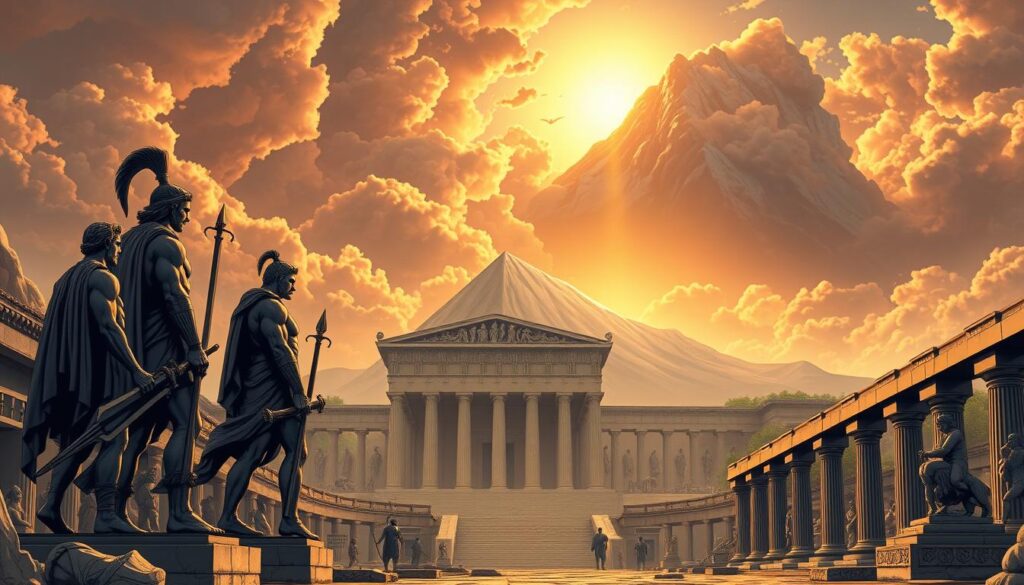
The myths of Perseus and Medusa are deep in ancient Greek stories. They mix gods’ actions and humans’ choices. This shows how ancient Greek heroes and their foes were shaped by divine politics and human dreams.
Perseus and Medusa’s tales show the ups and downs of divine favour and anger. Gods played big roles in their lives, shaping their paths. These stories are timeless because they talk about power, change, and destiny.
The Origins of Perseus
Perseus was born in a special way, thanks to divine parentage. His mom, Princess Danaë of Argos, got pregnant with Zeus’s help. This happened when Zeus came to her as golden rain, while she was locked in a bronze tower by her dad, King Acrisius.
King Acrisius wanted to avoid a prophecy that said his grandson would kill him. So, he locked Danaë away from men. But Zeus’s will couldn’t be stopped.
When Acrisius found Perseus, he didn’t believe in gods’ power. Fearing gods’ anger, he threw Danaë and Perseus into the sea in a chest. They were carried to Seriphus, where Dictys, a fisherman, saved them.
Dictys raised Perseus as his own, giving him a loving home. This upbringing made Perseus brave and kind, preparing him for his great adventures.
The Gorgon Medusa: A Brief Overview
Medusa’s story is complex, with different tales of her start. Early Greek stories say she was one of three Gorgon sisters, with snake-like hair and a deadly stare. But she was the only mortal, making her vulnerable to death.
Ovid, a Roman poet, told a different story that has shaped our views. He said Medusa was once a beautiful priestess in Athena’s temple. Her beauty caught Poseidon’s eye.
The tragic change happened when Poseidon attacked Medusa in the temple. Athena was angry, not at Poseidon, but at Medusa. She turned Medusa’s hair into snakes and cursed her to petrify anyone who looked at her.
This story makes us think about justice and blaming victims. Scholars see it as a look into ancient views on assault and victim-blaming. Medusa’s transformation shows the social death that often followed such events in ancient times.
Both Medusa’s stories show her power as a myth. Whether born a monster or changed by gods, she symbolises the scary power of women in ancient Greece.
Symbols & Attributes
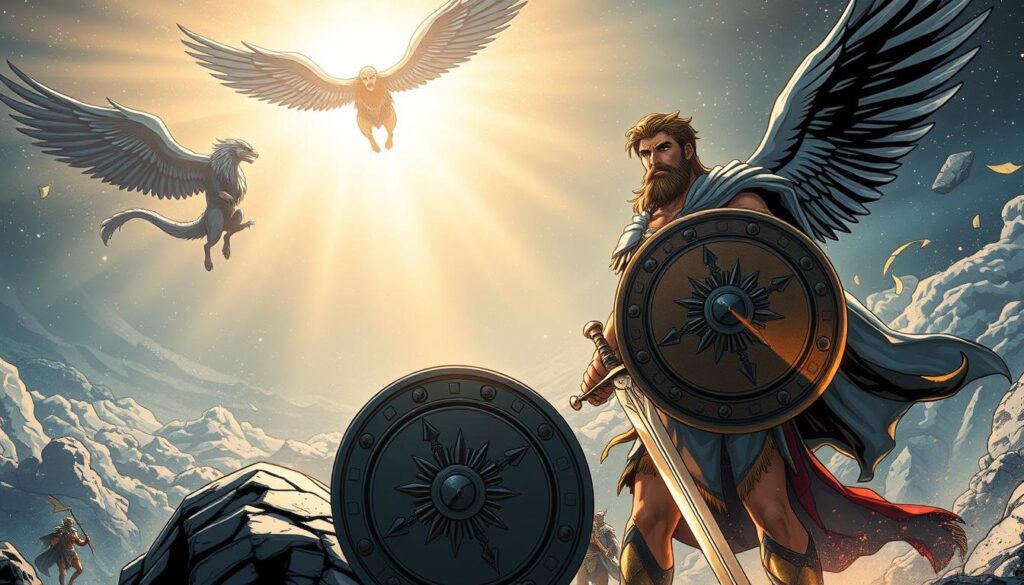
Perseus’s story is filled with symbols from his divine tools. These magical weapons and protective items mean more than just fighting tools. They show how human bravery and divine assistance work together in classical mythology.
The gods gave Perseus these gifts to help him win. But these gifts also stand for the virtues needed for victory. By looking at each gift, we see how ancient Greek stories teach us about wisdom, courage, and divine help.
The Iconic Shield of Perseus
Athena’s bronze shield is a key part of Perseus’s gear. It lets him see Medusa without getting petrified. This shield is more than just a tool for battle.
The shield’s bronze reflects wisdom through indirect perception. Perseus uses strategy and observation, not just strength. This shows Athena’s wisdom and cleverness.
The shield lets the hero see truth indirectly, not by facing danger head-on. In ancient myths, heroes often solve big problems with smart thinking, not just strength.
The Winged Sandals of Hermes
Hermes gave Perseus winged sandals for flying. These magical weapons let Perseus travel fast and reach Medusa’s lair safely.
The sandals mean freedom from earthly limits. They let Perseus move like a god, showing his divine speed and power.
The sandals also mean quick action. In myths, heroes must act fast when they can. These sandals help Perseus strike at the right time.
Other gifts, like Hades’ helmet of invisibility, add to Perseus’s arsenal. The harpe sword for beheading shows his ability to act decisively. The kibisis bag for Medusa’s head shows his control over danger.
These gifts show how divine assistance boosts human courage and wisdom in myths. Each item requires Perseus to show certain virtues while giving him the power to succeed in his quest.
Domains & Powers

Perseus had powers beyond what humans could do, making him a hero against ancient threats. He protected civilisation from chaos that could destroy order. His divine patronage and special abilities made him a symbol of humanity’s victory over darkness.
His impact went beyond winning battles. He stood for order winning over chaos. His powers were both physical and spiritual, linking humans to the divine.
Champion Against Monsters
Perseus became known as the ultimate monster slayer through battles with ancient Greece’s monsters. His victory over Medusa made him humanity’s defender against supernatural threats. This showed his bravery in facing challenges others avoided.
Beating Medusa was just one part of his heroic journey. He also saved Andromeda from a sea monster, showing his dedication to protecting the innocent. These acts made him a guardian in Greek legends.
His success came from divine gifts and his own courage. Magical items like Hermes’ sandals and Hades’ helm helped him. But it was his determination that truly made him stand out.
The Patronage of Athena
Athena favoured Perseus for his bravery and strategy. This divine patronage showed a deep spiritual bond between them. Athena saw in Perseus her own values: courage and intelligence.
Athena’s choice to use Medusa’s head as a shield turned chaos into order. This act showed how heroes can change the world. The Gorgon’s head became a powerful tool for protection.
Athena’s support made Perseus a favourite hero in Greek stories. Her backing showed his victories were not just luck but divine approval. This made him a standout hero in the Greek world.
The change of Medusa’s head from terror to protection showed humanity’s victory over ancient threats. Athena’s wisdom and Perseus’s bravery turned danger into a shield for all.
Temples, Worship & Cults
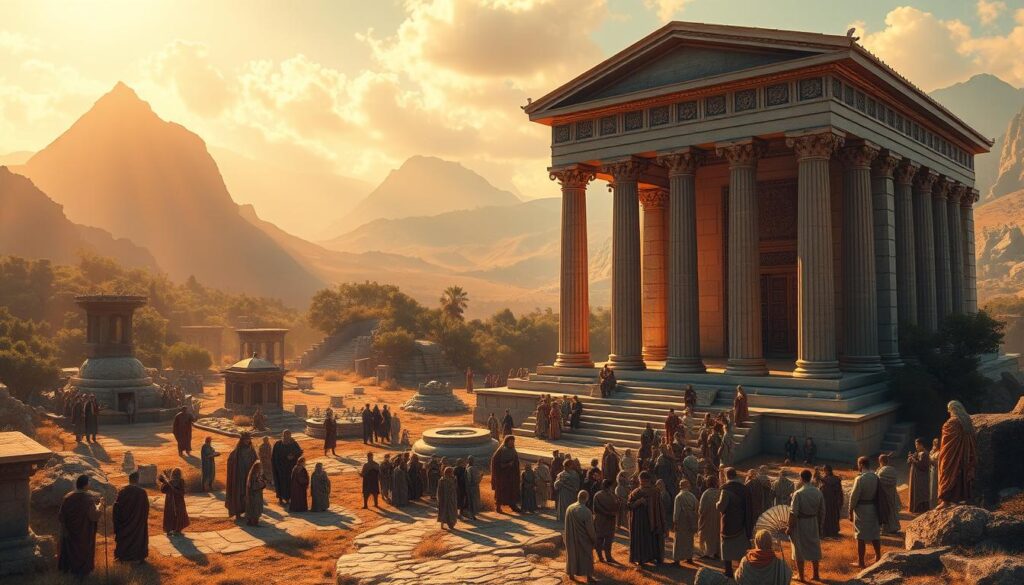
Perseus’s heroic deeds inspired many in Greece, leading to the creation of sacred sites and worship traditions. His legend grew into organised religious practices, honouring his divine favour and protection. Communities saw Perseus as both an ancestral hero and a guardian deity.
Perseus’s religious importance was greatest in areas tied to his myth. Ancient worship thrived where his presence was deeply meaningful to locals.
The Cult of Perseus
Heroic cults for Perseus mainly existed in the Argolid region. Here, he was revered as a legendary founder and protector. Through ceremonies and offerings, he was elevated to semi-divine status. Devotees believed he could protect against monsters and evil.
Festivals commemorating his victory over Medusa were central to these cults. Ritual dramas and processions recreated his adventures. These ceremonies strengthened community identity and invoked Perseus’s protection.
It was believed that Perseus’s divine parentage through Zeus gave him powers against supernatural threats. This belief fit well with Greek religious traditions, allowing heroic cults to thrive alongside worship of the Olympian gods.
Sacred Sites Dedicated to His Worship
Argos and Mycenae were home to the most important temples for Perseus. Archaeology shows these sacred sites had detailed decorations of his exploits. Scenes of his battle with Medusa and other adventures adorned the walls.
Perseus’s protective image was widespread, appearing on shields, buildings, and personal items. People believed these images could ward off evil and offer divine protection.
“The hero’s image served as a powerful guardian symbol, transforming ordinary objects into protective talismans through association with his legendary victories.”
Leaders used Perseus’s legend to justify their power, claiming descent from him. This shows how ancient worship served both spiritual and political purposes in Greek society.
Personality & Depictions
Perseus is a standout in Greek mythology, blending divine favour with human grit. His character goes beyond the usual warrior, showing intelligence and bravery. Through art, we see how cultures and times have seen heroism differently.
The Characteristics of Perseus
Perseus is known for his courage, intelligence, and resourcefulness. Unlike many, he solved problems with his mind, not just his strength.
His moral integrity shines in his quest to defeat Medusa. He did it to save his mother, not for fame. This shows his commitment to family and honour.
Perseus was adaptable and clever in his battles. He used Athena’s shield to look at Medusa, showing his creative thinking. This set him apart from others who fought head-on.
- Demonstrated unwavering courage in accepting impossible quests
- Showed compassion through his rescue of Andromeda
- Displayed wisdom in utilising divine gifts effectively
- Maintained humility despite achieving legendary status
Artistic Representations through the Ages
Artists have shown Perseus in many ways over time, reflecting cultural shifts and artistic styles. Ancient Greek pottery often showed him victorious, highlighting his role as a hero.
Classical art focused on his divine side, depicting him with magical tools. It showed him as a young, noble hero. These early works set the standard for future art.
The Renaissance brought a new view of Perseus. Benvenuto Cellini’s bronze sculpture in Florence is a prime example. It shows Perseus as a symbol of beauty and virtue.
Today, art explores Perseus’s inner world. Modern artists look at his moral side, challenging old hero stories. Yet, they keep his courage and determination at the forefront.
Family Connections
Perseus’s family in Greek mythology links gods, heroes, and mortals. This shows how heroic ancestry shaped the ancient world. His family tree is a key part of classical literature.
Perseus’s family shows how divine intervention and human choices create lasting legacies.
The Lineage of Perseus
Perseus’s divine lineage starts with Zeus, the king of gods, and Danaë, a mortal princess. This mix made him a demigod with special powers and human weaknesses.
Danaë, his mother, was very important. She was locked away by her father because of a prophecy. She raised Perseus with courage and determination. This shaped his heroic actions, like his quest for Medusa’s head.
A prophecy haunted his family. Perseus accidentally killed his grandfather, Acrisius, during games in Larissa. This showed that fate is unstoppable, even for heroes.
Key Relations within Greek Mythology
Perseus married Andromeda, a princess from Ethiopia. This marriage linked Greece and Africa. Their love story is a classic in classical literature.
Their children started the Perseid dynasty, a key family in Greek mythology. Their son Perses was the ancestor of the Persians. Other children ruled over the Mediterranean.
Most importantly, Perseus’s family produced Heracles, Greece’s greatest hero. Through Alcmene, a descendant, Perseus’s line kept creating heroes. This made Perseus a key figure in Greek heroism.
Perseus was also connected to other mythological figures. Athena supported him, and his fight with the Gorgons added to his mythological importance.
Perseus’s family shows how Greek myths explain cultural ties and heroic traditions. It links gods, heroes, and mortals across generations.
Stories & Myths
Perseus’s heroic adventures are among the greatest in ancient Greek myths. They show courage and divine help can conquer big challenges. For thousands of years, his stories have made him a legendary hero.
Perseus’s legendary deeds are not just one story. He faced many supernatural beings, saved princesses, and got divine help. Each tale adds to his heroic journey, showing his amazing abilities.
The Slaying of Medusa
Perseus’s most famous quest was to slay Medusa. King Polydectes sent him on this mission, thinking it was a death sentence. But Perseus didn’t know it would make him a hero.
First, Perseus found the Graeae, three sisters with one eye and tooth. They knew where to find the magical items he needed. Perseus tricked them into giving up their eye, getting the location of the Hesperides in return.
The Hesperides gave Perseus three key items: winged sandals, a magical wallet, and Hades’s helmet. Athena gave him a shield, and Hermes gave him a sickle to cut through Medusa’s scales.
Confronting Medusa needed cleverness, not strength. Perseus looked at her reflection in Athena’s shield to avoid her deadly stare. He then used the sickle to cut off her head.
Medusa’s blood created Pegasus and Chrysaor. These beings symbolised new life from destruction. Perseus put Medusa’s head in his wallet and escaped before her sisters could attack.
Other Adventures and Encounters
Perseus’s heroic adventures didn’t stop with Medusa. He flew over Ethiopia and saved Princess Andromeda from a sea monster. Her mother’s boast had angered Poseidon.
Rescuing Andromeda showed Perseus’s bravery and kindness. He married her after defeating the monster. This act of heroism saved the kingdom.
Perseus also met Atlas, who was holding up the heavens. Atlas refused to help Perseus, fearing a prophecy. Perseus used Medusa’s head to turn Atlas into a mountain range.
Perseus’s last battle was with King Polydectes. He had been bothering Perseus’s mother, Danaë. Perseus turned Polydectes and his followers to stone at a fake wedding.
| Adventure | Challenge Faced | Divine Assistance | Outcome |
|---|---|---|---|
| Medusa Quest | Slaying an immortal Gorgon | Athena’s shield, Hermes’s sickle | Successful beheading, birth of Pegasus |
| Andromeda’s Rescue | Defeating sea monster Cetus | Medusa’s petrifying head | Monster turned to stone, marriage to Andromeda |
| Atlas Encounter | Refused hospitality by Titan | Medusa’s continuing power | Atlas transformed into mountain range |
| Polydectes Confrontation | King’s harassment of mother | Medusa’s head as weapon | King and supporters petrified |
Perseus’s stories show he was more than a one-time hero. He was clever, brave, kind, and just. Each adventure made him more famous and added to Greek heroic tales.
Perseus’s tales are loved for their mix of human effort and divine help. His legendary deeds inspire today, proving ancient myths are timeless and universal.
Representation in Art & Culture
The story of Perseus has inspired many artists over the years. From ancient Greek pottery to modern sculptures, his cultural influence is vast. His tale of heroism, power, and change has captivated artists for centuries.
Perseus has been depicted in many ways, from marble sculptures to digital art. His story is full of symbols that speak to different times and cultures.
Depictions in Ancient Art
Ancient Greek artists often showed Perseus on pottery and in buildings. Red-figure vases from the 5th century BCE depicted him holding Medusa’s head. These early works set the stage for future artistic traditions.
Architectural friezes also featured Perseus, seen in temples across Greece. The Parthenon’s metopes included scenes from his adventures. These public artworks made him a cultural hero and divine protector.
Roman artists took Greek traditions and added their own twist. Mosaics in Pompeii and other places showed Perseus saving Andromeda. These works highlighted both the heroic and romantic sides of his story.
Modern Adaptations and Influences
Renaissance masters like Benvenuto Cellini created famous bronze sculptures of Perseus. Cellini’s 1554 masterpiece in Florence combined classic heroism with Renaissance art. This work shows how Perseus’s artistic legacy changed over time.
Today, artists offer modern interpretations that challenge old stories. Luciano Garbati’s 2008 sculpture “Medusa with the Head of Perseus” flips the power dynamic. This work, seen during the MeToo movement, symbolises female strength and resistance.
Literature and cinema keep bringing Perseus’s story to new audiences. Films like “Clash of the Titans” share his tale worldwide. Video games and graphic novels offer interactive modern interpretations for younger fans.
| Period | Artistic Medium | Key Characteristics | Cultural Significance |
|---|---|---|---|
| Ancient Greece | Pottery & Sculpture | Heroic triumph scenes | Divine protection symbolism |
| Renaissance | Bronze & Marble | Humanist ideals | Classical revival movement |
| Contemporary | Mixed Media | Feminist reinterpretations | Social justice themes |
| Popular Culture | Film & Digital | Entertainment focus | Global accessibility |
Perseus’s story shows how myths evolve with time. His tale continues to inspire artists to explore themes of power, justice, and change. This ongoing cultural influence keeps Perseus relevant in today’s art world.
Museums around the world display Perseus-themed artworks from different eras. These collections show how his artistic legacy crosses time and place. Each new generation finds fresh meanings in his ancient story.
Interesting Facts
The Perseus myth goes beyond old stories, touching unexpected parts of our culture and knowledge. It shows layers of meaning that keep scholars and fans hooked.
Celestial Immortality and Hidden Details
Perseus became a star in the ancient sky. The stars tell his story, with Perseus, Andromeda, and others forming constellations. This lets us follow his journey through the night sky.
Medusa’s blood had two sides, showing ancient Greek ideas. One side was deadly, the other healing. This shows the balance between harm and creation in old thinking.
Modern Interpretations and Enduring Impact
Today, scholars look at Perseus through different cultural views. Feminist views challenge the classic hero story, looking at power and violence. The myth changes in different places, showing what was important to ancient Greeks.
Perseus’ story has shaped the idea of monster-fighting heroes in today’s tales. His legacy is more than just stories. It helps us understand heroism, justice, and complex morals. The myth shapes our views on power and responsibility in today’s world.
